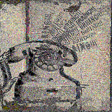2009W
2.10.2009
Arts 102 UCSB
Noise Project
Christopher Faredan
The first project filters in from the background down to the
character. The Noise lessens as it approaches the hands. The hands are
the only part of the image that is un-enhanced or noised. The lips,
which are the source of the silence has its colors enhanced.
Deborah Chong
I wanted to visually explain through an image that noise comes
directly from cell phones, landline telephones and other various
technologies. As most of us have a phone device close to us, each
individual contribute to the noise pollution. When a phone rings,
then noise is produced and causes the people to hear. I feel that each dot represents a person using their electronic
phone device. The noise of using or hearing a phone affects one
person to the other and the atmosphere.
Sean Finch
MC
I was particularly inspired by the Wikipedia definition of electronic noise: In any electronic circuit, there exist random variations in current or voltage caused by the random movement of electrons carrying the current as they are jolted around by thermal energy. While this is a literal definition, I am using it as a metaphorical one. I am interested in visually describing the electricity of attraction, the voltage caused by two people locking eyes, the thermal energy exchanged with the brush of a hand, in passing, and the brief moment of clarity in the chaos of noise. For this project I chose to use a still image that already carried the weight of "attraction" as a theme, so that I could concentrate on emphasizing the passage of time. Technically, I added noise to the shadows of the image and then blurred the noise with the radial blur function. I then chose to erase some of the noise and blur from the center of the frame so as to draw focus to the relationship between these two figures.
Naree Park
An interactive noise project in processing.org - code.
Cameron Boulton
InputNoise is created in processing.org. It uses the input from your microphone or line-in
to generate noise! Right now it is only configured for a monaural
(single channel) input, but could be changed to accommodate stereo input
as well. Each frame, a pixel is colored from 0-255 based on the
amplitude wave detected by the microphone. The values from -1 to 1 are
mapped to 0 to 255, so expect middle gray for no sounds and black/white
for loud sounds. Code.
Jana Sepulveda
I wanted to show this idea of being completely overwhelmed by noise and the world around you. The idea is that you, as an individual, are small and insignificant in the space of things, but as a whole, you make up something magnificent. I don't know if that makes sense or not. Noise is all around us in every second of every day in a variety of ways and we take no notice. So I wanted to create an image which sort of represents the small part being a part of the whole, but also that we coexist with this noise every second of every day and it becomes a part of us.
Amanda Appel
PALINOPSIA (Greek: /palin/ for "again" and /opsia/ for "seeing")
is a visual disturbance that causes images to persist to some extent
even after their corresponding stimulus has left. These images are
known as afterimages and occur in persons with normal vision.
However, a person with palinopsia experiences them to a significantly
greater degree, to the point where they become difficult or impossible
to ignore. This often results in mild to severe anxiety and/or depression.
Palinopsia sometimes appears on its own, but is more often accompanied
by other visual disturbances such as visual snow, and is frequently,
though not exclusively, encountered as a symptom of hallucinogen
persisting perception disorder.







